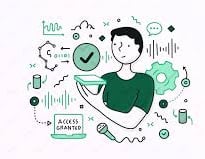Introduction
In the world of cybersecurity, Authorization determines who gets access to systems and data. Without a proper authorization framework, organizations risk giving unauthorized users the keys to the kingdom. It's more than just saying, "You’re in." It's about managing access to critical systems, enforcing the principle of least privilege, and ensuring users only have access to what they need.
Abstract
Overview
Authorization is a fundamental aspect of cybersecurity. It ensures that users, applications, or devices can only access resources they’re permitted to. Effective authorization systems prevent unauthorized actions and protect the integrity of digital environments. In today’s world, with the rise of AI, we’re seeing more intelligent, automated ways to manage authorization, making systems smarter and more secure.
Authorization is the gatekeeper of digital security—deciding who gets in and what they can do once they're there. Think of it like a VIP list at a party. Without the proper controls, anyone could stroll in and wreak havoc. In this blog, we'll explore why solid authorization practices are essential, how Generative AI can improve them, and how SecureKnots can help businesses create robust authorization strategies to protect sensitive systems.


[Disclaimer: This blog post is for informational purposes only and should not be construed as legal or financial advice. Organizations should consult with legal counsel and regulatory authorities to ensure compliance with reporting requirements.]
Mandatory
Authorization is mandatory for securing any system or network. Proper authorization is a key safeguard against data breaches and cyberattacks, ensuring that only trusted entities have access to sensitive information.
Applicability
Authorization applies universally across organizations and industries, from banking and healthcare to government and retail. Wherever data is involved, robust authorization controls are required.
Regulatory or Company Interest?
Regulatory standards like GDPR, HIPAA, and PCI-DSS require strict access controls to safeguard personal and financial data. Non-compliance can lead to hefty fines and loss of trust.
Key Guidelines
Implement role-based access control (RBAC)
Use the principle of least privilege—give users only the access they need
Regularly review and update user access privileges
Integrate AI for more adaptive and secure authorization processes


Key Implications
Strong authorization practices help mitigate the risk of data breaches, unauthorized access, and insider threats. Weak authorization, however, opens the door to significant security vulnerabilities.
Countries with Adoption or Influence
Countries like the US, UK, and Germany have adopted rigorous authorization standards in industries such as finance, healthcare, and government to ensure compliance with data protection regulations.
International Frameworks Influenced
International frameworks such as NIST SP 800-53 and ISO 27001 emphasize the importance of robust authorization systems for safeguarding sensitive data and ensuring regulatory compliance.
Regional and Industry-Specific Frameworks
Specific sectors, like healthcare and finance, have heightened authorization requirements due to the sensitivity of the data they handle. Industry-specific standards often mandate granular access controls and continuous monitoring.
Secure Your Digital Identity with SecureKnots
Contact us to learn more about our cybersecurity services and ensure your organization meets cybersecurity requirements.


Conclusion
Authorization is more than just giving access to systems—it’s about protecting valuable resources from unauthorized users. By using tools like Generative AI, organizations can strengthen their access management systems and ensure that access is given only to those who need it.
How SecureKnots Can Help?
SecureKnots helps organizations implement and audit authorization frameworks through our GRC consulting services. Our VAPT services can identify weaknesses in access control systems, while our security awareness training educates users on the risks associated with improper access. Additionally, our ransomware and phishing simulations test how well your authorization controls stand up against social engineering attacks. Let SecureKnots help you fortify your authorization processes and keep your systems secure.
This blog focuses on the importance of securing employee access to internal systems while showcasing how SecureKnots can help organizations strengthen their access controls. It is informative and engaging, highlighting the significance of strong Authorization practices. Let me know if you need further adjustments!
Thank you for your attention! If you have any inquiries about cybersecurity requirements or need expert guidance, please don't hesitate to contact SecureKnots.
This should wrap up the blog and fulfill the promise made in the previous one!
Authorization- Who Gets the Key
When it comes to securing digital systems, Authorization is like the VIP list for a party. It determines who’s allowed in, who’s not, and what they can do once they’re in. Without proper authorization, it's like leaving the front door wide open for anyone to walk in. Yikes, right?
But don’t worry, with Generative AI, we can make this process smarter and more efficient than ever. Here’s what we’ll be covering in this series
WITH OUR SHORT BLOGS
STAY UP TO DATE
Copy Rights @ 2023 SecureKnots. All Rights Reserved.
CONTACT US
Contact@Secureknots.com
USA
+1-302-601-2346
+1-302-608-6708
INDIA
080-31658865
GET IN TOUCH
